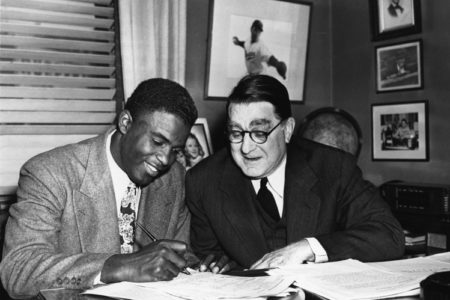The Man Who Changed Baseball
 Most baseball fans have heard the name Branch Rickey, but they’re unaware just how much he was responsible for the modern game of baseball.
Most baseball fans have heard the name Branch Rickey, but they’re unaware just how much he was responsible for the modern game of baseball.
Perhaps they’ve even seen pictures of his ministerial glare. The quintessential taskmaster. But behind the conservative aura was a brilliant baseball mind that changed the game, not just once, but twice. A mind that conceived momentous changes with far reaching implications.
Rickey’s Inventions
Rickey’s invention of the farm system has become a competitive sport in major league baseball today. There are now analytical agencies that evaluate whose farm system is the best, the worst, which players may become household names and which players are already suspect. Every team plays this game, and like the game itself, some are better than others and reap the rewards of their excellence, or is it luck?
In Rickey’s case, it was hard work and dedication.
His second decision was the first shot heard round the world. Beating Bobby Thomson’s 1951 pennant winning blast over the left field fence by a full five years. It was that decisive a change. Mention a name, two words, and even your grandmother will know what Rickey did—or she should. Later, for this.
Down on the Farm
Let’s begin in 1918.
After four years with the St. Louis Browns (as player, manager and the general manager responsible for signing the great Hall of Famer George Sisler) Branch Rickey left the Browns as a 37-year-old journeyman after a less-than-stellar baseball playing and managing career. He joined the crosstown St. Louis Cardinals. Within two years he was a field manager (again), but he was fired shortly into the 1925 season.
Even as he was managing, Rickey was obsessed with discovering more efficient ways to secure talent. He began his player development scheme by convincing Sam Breadon, the Cardinals owner, to invest in a class C Western Association minor league franchise in Fort Smith, Arkansas. Then Breadon bought a majority interest in the Houston Buffaloes of the Texas League. By 1921 the Cardinals had added a franchise in upstate New York in the International League.
Rickey’s development program was off and running.
With Breadon’s money invested in small teams in semi-pro leagues around the country, Rickey and his scouts signed young players cheap and sent them to their teams to develop into frontline players. Rickey also instituted a training regimen every player would follow—no matter which semi-pro or minor league squad in the Cardinals universe they were assigned to. So, once a player signed with St. Louis, he was developed the Cardinals’ way.
Breadon fired Rickey early in the 1925 season and replaced him with Rogers Hornsby. But Breadon recognized Rickey’s value as a talent evaluator and rather than sending him packing, made him the Business Manager of the Cardinals. An astute judgment.
By allowing Rickey to continue building the foundation he had started in 1920, Breadon laid the groundwork for Rickey’s vision of Cardinal baseball which paid off in 1926 with their first World Series victory. And as more and more young players joined the team, the Cardinals would become the elite of the National League and win three pennants between 1926 and 1930.
Rickey continued his experiments in player development, scouring the hills and valleys of the country to find more hidden gems who would begin to fill the rosters of his low ‘D’ class minor league and semipro teams he had invested in. By 1925 the Cardinals began to sponsor tryout camps for new players in Danville, Illinois; and a few years later in 1928 they opened a second camp in Shawnee, Oklahoma.
And it was out of Shawnee in 1930 that Rickey found a country boy who threw unhittable right-handed thunderbolts. Big and rawboned, he would become the future Hall of Famer Jay Hanna “Dizzy” Dean.
Soon enough Pepper Martin, Joe “Ducky” Medwick and Paul “Daffy” Dean, would join “Dizzy” as core members of the “Gashouse Gang.” Early 1930s. The “Gang” was the basis for the Cardinals’ success the next five years. No one was surprised when they won the World Series in 1931 and 1934. Those were talented, gritty players at the top of their skills.
By the time Rickey left the Cardinals in 1942, the team would win three more World Series in quick order: 1942, 1944 and 1946. That’s six World Series victories over 23 seasons, only the Yankees with ten would win more.
Rickey left the Cardinals with a full cupboard of supplies. But by the 1940s, the Cardinals’ organizational patterns and successes became the gold standard to copy. Maybe that was the reason the Cardinals would not win another World Series until they beat the Yankees in 1964. Too many other teams beat them at their own game.
Or maybe it was because Rickey left.
Or, maybe they weren’t looking for the same hidden gems Rickey was. Once Rickey arrived on Empire Boulevard and Bedford Avenue in 1943, being a General Manager was not enough. Maybe he thought he would be in Brooklyn the rest of his career. Not merely until 1950. Or perhaps he had finally thought through the most efficient way to win a championship.
Or maybe it was something else. Old wounds that he had lived with for almost half a century were aching once more. He finally felt strong enough to want to make a real difference. As a man. And a baseball man. To finally be true to his own self. In Brooklyn.
The Courage of His Convictions
Branch Rickey had experienced the white and black side of athletics at the turn of the 20th century, as teammate and manager. He had played football with the first black professional football player, Charles Follis, in the early 1900s. Follis, like every other black athlete Rickey had known, played under the pressure of racism. Rickey admired the man’s poise, his athleticism, and his drive to excel, even as he was heckled mercilessly.
About the same time, in 1903 and 1904, Rickey coached a black catcher, Charles Thomas, on the Ohio Wesleyan baseball team. Thomas suffered the abuse of profanity and degradation every day. Yet he weathered that daily storm with class and honor, refusing to knuckle under to the incivilities hurled at him from every direction.
Rickey watched Thomas closely as he managed Ohio Wesleyan and was touched by the man’s inner strength. He never forgot that strength. And when the time came to make the most critical baseball decision of his life, though the name he chose would not be Thomas, the man would be very much like him.
Rickey’s genius lay in not only finding and valuing players, but in taking risks to make his ball club better. Making shrewd trades others wouldn’t consider. He faced the truth about the strengths and weaknesses of his teams. And when he took over Brooklyn he faced some hard truths. How to improve a team that had just won its first National League pennant in 1941 for the first time in 20 years.
What could he add to the mix to make Brooklyn a champion?
That’s when the name Charles Thomas buzzed around inside his head. He knew what had to be done, and he did it.
He needed a sparkplug. An infusion of energy and creativity in the lineup. That’s why following the 1945 season, Rickey signed a Charles Thomas by the name of Jackie Robinson from the Negro American League’s Kansas City Monarchs and offered him a minor league contract to play for the Montreal farm club of the Brooklyn Dodgers during the 1946 season.
It was a minor league deal, but there was also an unspoken truth. An incredible future might lay ahead.
Robinson’s 1946 season proved that Rickey was right. Robinson was exactly the kind of player that Brooklyn needed. Especially if they wanted to hurdle the next threshold. And Rickey was about success, about creating winning baseball teams. And Jackie Robinson would be the catalyst of a decade of great Brooklyn baseball no one in the borough would ever forget.
Robinson started the 1947 season with the Dodgers, and nothing would be the same in Brooklyn the next decade.
The Brooklyn Dodgers would win the National League pennant in 1947, 1949, 1952, 1953, 1955, and 1956, and they would win the World Series in seven grueling games against the New York Yankees in 1955. Their apotheosis. Rickey’s zenith, even though he had moved on to the Pittsburgh Pirates a few years before. That would be his last World Series victory. Buzzy Bavasi took the reins of the Dodgers in 1951 (and would remain GM until 1968).
The rest was history. Rickey singlehandedly changed the competitive balance of baseball. Teams that were slow to offer contacts to black players, fell behind. Teams that signed Willie Mays and Monte Irvin and Henry Aaron and Don Newcombe and Roy Campanella, competed for championships in the 1950s.
So the 1950s were about the impact that black players had on Major League baseball. Willie Mays (1979 HOF). Jackie Robinson (1962). Hank Aaron (1982). And Roberto Clemente (1973), dominant players all, won the World Series and ended up in the Hall of Fame.
Even into the 1960s, the National League was the more competitive of the two leagues, because so many black stars played on National League clubs. While American League teams were slow to sign black players.
So, while Frank Robinson was traded from the Cincinnati Reds (1956-1965) to the American League Baltimore Orioles in 1966 (where he played until 1971) and then finished his career with a few other teams, he was a National League player initially, and was voted into the Hall of Fame in 1982 wearing an Oriole cap, where he achieved his greatest success.
The first black American League player to make the Hall was Rod Carew in 1991. Almost ten years after the first great group of black players had changed the tenor of major league baseball.
All because Branch Rickey had a reservation stuck in his craw for half a century.

























